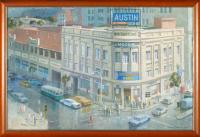Estimate: $5,000/$8,000
Frank Norton was not an artist known for pushing boundaries, but rather for
his dedication to faithfully capturing the world around him. He was not
driven by a desire to break new ground in the art world, but by a
commitment to providing an artist's perspective on everyday events.
...
Norton's reputation, achievements, and military service have been
well-documented. He was appointed an official war artist during both World
War II and the Korean War. Following these wartime assignments, he taught
at the East Sydney Technical College. Before being appointed as the
Director of the Art Gallery of Western Australia from 1958 to 1976, a
position that allowed him to significantly influence that institution's
direction.
With the support of his dedicated staff, Norton expanded the gallery's
collection of Aboriginal artefacts and Australian Impressionist works. He
also designed and oversaw the construction of the current Art Gallery of
WA, while managing to navigate challenging press coverage when some of the
gallery’s acquisitions were deemed controversial.
Amidst these professional responsibilities, Norton remained focused on his
personal artistic practice, and travelled extensively within the state in
his professional capacity. He meticulously documented his surroundings,
making detailed notes and sketches of the world he encountered. These
observations were not merely for personal expression but intended as a
record for future generations.
One lesser-known aspect of his wartime service is his close call during the
Battle of Tobruk, where he was nearly killed by shellfire. As the explosion
threw him in one direction and his easel and paints in another, Norton’s
determination to document the realities of war persisted. Unlike many
artists of the time, he chose not to focus on the sensational, heroic
moments that were widely reported, but on the daily routines and seemingly
mundane tasks that, in his view, were essential to the success of the
military effort. These uncelebrated moments were, for him, just as
significant as the acts of bravery that earned medals.
This 1972 oil painting depicts the Winterbottom Motors building at the
corner of St Georges Terrace and Mill Street in Perth on a rainy day. It
exemplifies the artist’s keen eye for detail and his ability to capture the
ordinary events of daily life. Over time, such scenes have become valuable
records of a city that continues to undergo significant change. The artist
goes beyond simply recording the vehicles, buildings and fashion of the
time; in the background, he also includes dredging activity in the Swan
River.
Through his steadfast commitment to observation and documentation, Frank
Norton offered a quiet yet powerful alternative to the more dramatic
narratives of his time. His work stands as a testament to the enduring
value of the ordinary — the streets we walk, the work we do, the moments we
often overlook. In capturing these fragments of daily life with precision
and care, Norton created not just art, but a visual history that continues
to resonate. His legacy lies not in revolutionizing artistic technique, but
in elevating the everyday to a place of significance, ensuring that the
seemingly mundane is remembered with the dignity it deserves.
Read more


